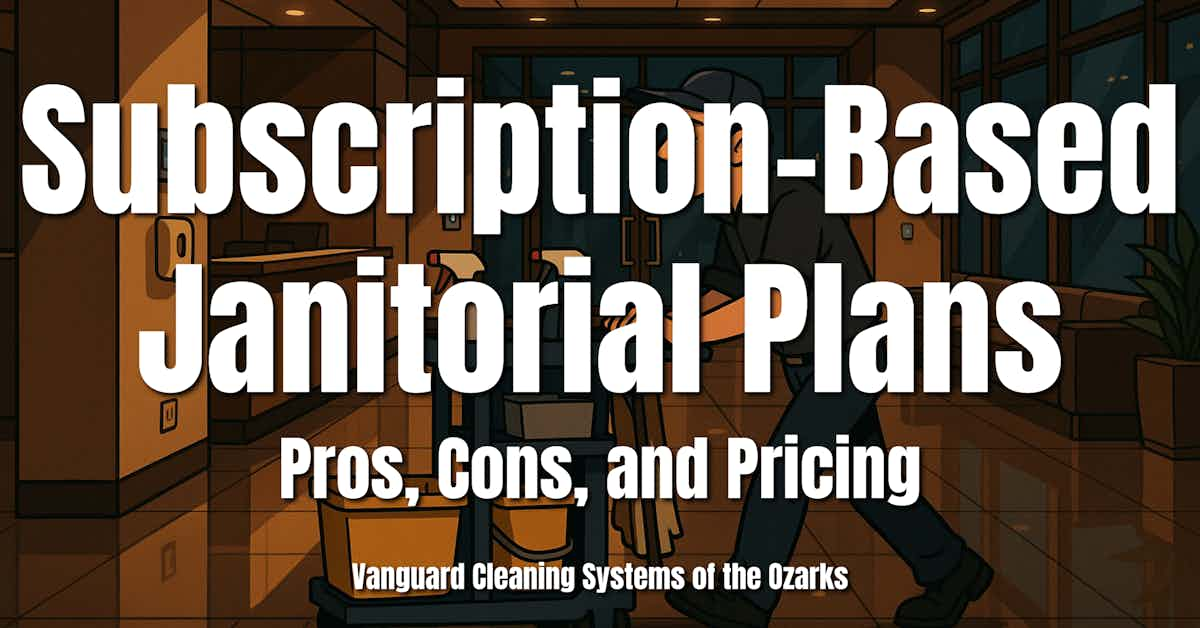Subscription-based janitorial plans promise predictable costs and consistent service, but come with trade-offs in flexibility and value.

Rethinking Janitorial Services Through Subscription Models
Commercial cleaning is a critical component of maintaining healthy, productive environments in schools, offices, healthcare facilities, and retail spaces. For decades, organizations relied on hourly or per-visit janitorial contracts, which created unpredictability in both cost and service delivery. In recent years, however, the subscription-based janitorial model has emerged as a new approach.
Much like subscription services in software, entertainment, and logistics, janitorial subscriptions provide recurring, flat-rate cleaning plans. These models promise predictable costs, standardized service, and stronger accountability. For facility managers juggling budgets, compliance requirements, and user satisfaction, this shift represents both an opportunity and a challenge.
This article examines subscription-based janitorial plans in depth, providing an EEAT-aligned analysis of their advantages, disadvantages, and pricing structures. Drawing from industry research, facility management trends, and cleaning service benchmarks, it equips decision-makers with actionable insights and practical steps to evaluate whether these plans align with their needs.
The Rise of Subscription Models in Facility Services
Subscription models are not new. Newspapers and magazines relied on subscriptions for centuries, and in recent decades, digital platforms normalized monthly billing for streaming, fitness, and productivity tools. The underlying appeal is universal: convenience, predictability, and value retention.
The janitorial industry has historically lagged in adopting this approach, relying instead on hourly billing or short-term service contracts. Hourly models created disputes over time spent, while per-visit pricing often led to inconsistent budgeting. Clients wanted more cost stability and service accountability, and providers sought more predictable revenue streams.
The result was the introduction of subscription janitorial plans—monthly or annual agreements that standardize cleaning tasks for a flat fee. These plans are especially attractive to:
- Schools and universities with fixed annual budgets.
- Small businesses seeking predictable overhead costs.
- Healthcare and retail facilities requiring consistent sanitation.
- Multi-tenant properties balancing multiple stakeholders’ expectations.
By shifting incentives from billing hours to retaining clients, subscription models encourage providers to deliver reliable service while streamlining client costs.
Advantages of Subscription-Based Janitorial Plans
Cost Predictability
The foremost benefit is financial stability. With fixed monthly fees, organizations eliminate the surprise of fluctuating invoices tied to variable labor hours or unexpected needs. For budget-constrained schools or nonprofits, this allows for precise allocation of funds.
Actionable Insight: Compare projected subscription costs with historical monthly invoices. If costs fluctuate more than 15% in the hourly model, a subscription likely creates savings.
Service Consistency and Accountability
Subscription contracts typically outline specific cleaning tasks and frequencies. Providers must deliver to retain the client, which creates natural accountability. Unlike hourly billing—where efficiency may reduce revenue for providers—subscriptions reward consistent, quality service.
Actionable Insight: Request checklists and quality assurance protocols before signing. Tie payments to performance benchmarks such as complaint reduction or cleanliness scores.
Operational Efficiency
Subscriptions streamline operations. Providers reduce administrative burdens from invoicing, while clients save time negotiating service visits. Some contracts even include priority scheduling, ensuring urgent needs are addressed quickly.
Actionable Insight: Negotiate priority windows for high-traffic areas such as cafeterias, gyms, or restrooms.
Value-Added Perks
To differentiate, many providers bundle perks such as free deep cleans, discounted specialty services, or waived emergency fees. These extras increase the value of the subscription and strengthen long-term client relationships.
Actionable Insight: Compare multiple vendors’ perks. Select those aligned with your highest operational risks, such as water damage response or infection control cleaning.
Disadvantages of Subscription-Based Janitorial Plans
Potential for Higher Long-Term Cost
If a facility’s needs are minimal or sporadic, subscriptions can cost more than ad-hoc hourly service. A small office that requires only occasional cleaning may find itself overpaying for unused capacity.
Contract Lock-In
Many providers require six- or twelve-month commitments. Early cancellation may involve penalties or forfeited discounts. Organizations with fluctuating occupancy or uncertain budgets may find this risky.
Reduced Flexibility
Fixed scopes may not adapt to events like school assemblies, retail holidays, or seasonal illness outbreaks. While most providers offer add-ons, they are billed separately, which undermines the predictability of the subscription model.
Risk of Under-Service
Some providers may overextend themselves, focusing on volume rather than quality. If accountability systems are weak, facilities may experience under-delivered service despite paying a fixed fee.
Actionable Insight: Include performance metrics in contracts. Examples include restroom supply stockouts per 1,000 users, complaint response time, and cleanliness survey scores.
Pricing Structures in Subscription Janitorial Services
Pricing depends on four main variables:
- Facility Size: Larger square footage increases cost proportionally.
- Frequency of Service: Daily cleaning costs more than weekly or bi-weekly schedules.
- Scope of Work: Basic cleaning (trash, vacuuming) costs less than full custodial care (disinfection, deep cleans).
- Geography: Labor rates, competition, and regulatory requirements vary by region.
General Benchmarks
- Small offices (2,000–5,000 sq. ft.): $200–$500 per month.
- Medium facilities (5,000–20,000 sq. ft.): $500–$2,000 per month.
- Large campuses (>50,000 sq. ft.): Custom pricing, often $0.05–$0.15 per square foot monthly.
Some providers offer tiered packages:
- Basic: Trash removal, sweeping, and restroom cleaning.
- Standard: Adds vacuuming, surface disinfection, and window cleaning.
- Premium: Includes deep cleaning, specialty floor care, and eco-friendly products.
Actionable Insight: Request itemized inclusions at each tier. Ensure pricing aligns with both square footage and compliance requirements (e.g., OSHA, infection control).
Comparing Subscription vs. Hourly Models
| Factor | Subscription Plan | Hourly/Per Visit Plan |
|---|---|---|
| Cost Predictability | Fixed monthly fee | Variable; fluctuates with usage |
| Service Accountability | Provider incentivized to maintain retention | Dependent on hours billed, less incentive |
| Flexibility | Limited unless add-ons available | High; can scale up or down as needed |
| Risk of Overpaying | High for low-use facilities | Low; pay only for what you use |
| Administrative Burden | Low—simple billing | High—multiple invoices, approvals |
| Strategic Fit | Best for consistent, predictable cleaning needs | Best for irregular, low-volume needs |
Actionable Insight: Facilities with steady, high-traffic usage gain the most value from subscriptions. Low-traffic or highly variable facilities may prefer hourly contracts.
Industry Examples and Case Trends
- Office Buildings: Corporate campuses often use subscriptions to stabilize budgets across multiple tenants.
- Schools: Districts lock in annual custodial budgets, aligning with fiscal calendars. Subscriptions also ensure consistent restroom and cafeteria cleaning.
- Healthcare: Predictability supports compliance with health standards, though flexibility is often required for infection surges.
- Retail: Stores benefit from consistent presentation but may require add-ons during peak shopping seasons.
Emerging Trend: Some janitorial companies pair subscription models with IoT sensor data. Restroom dispensers, occupancy counters, and leak detectors trigger cleaning tasks on demand, aligning subscription plans with smart facility management.
Barriers to Adoption
Privacy and Security
If sensor integrations are included, schools and healthcare facilities must ensure data collection does not compromise personal privacy.
Training and Staff Integration
Even subscription models require oversight. Without staff coordination, service levels may drift.
Contract Transparency
Some providers bury cancellation penalties or exclude specialty services. Clear contract language is essential.
Actionable Insight: Use third-party performance audits quarterly to confirm service delivery matches contract promises.
Actionable Implementation Steps
- Audit Current Costs: Collect 12 months of invoices under the current billing model.
- Define Scope Needs: Identify core services (daily vs. weekly vs. specialty).
- Run Cost Scenarios: Compare hourly vs. subscription based on usage.
- Pilot Test: Start with one building or department before rolling out campus-wide.
- Set KPIs: Examples include supply stockouts, complaint rates, and cleanliness survey scores.
- Review Annually: Adjust frequency or tier to reflect actual facility use.
Frequently Asked Questions (FAQ)
How do subscription janitorial plans save money?
They stabilize budgets, reduce administrative overhead, and often include perks such as discounted specialty services.
Are they suitable for schools?
Yes—schools benefit from fixed budgeting cycles, consistent sanitation, and reduced emergency cleaning costs.
What risks should managers watch for?
Overpaying in low-use settings, contract lock-in, and insufficient flexibility for special events.
Can subscriptions integrate with sensor technology?
Yes—some providers use occupancy sensors and dispenser monitors to align cleaning with real-time needs.
Conclusion
Subscription-based janitorial plans reflect a broader shift toward predictable, value-driven service models. For organizations with consistent cleaning needs—schools, healthcare facilities, office complexes—the advantages include budget stability, accountability, and operational efficiency. Yet, like any model, subscriptions carry risks: higher long-term costs for low-usage facilities, reduced flexibility, and potential vendor lock-in.
The key is alignment. Facilities that define their service scope, set clear KPIs, and negotiate transparent contracts can unlock significant value. Conversely, those that enter subscriptions without analyzing needs risk paying for services they do not require.
For facility managers seeking predictable budgets, measurable outcomes, and stronger provider accountability, subscription-based janitorial plans represent a compelling option. As the industry continues to integrate sensor technology and data-driven insights, these models may soon become the standard for modern facility management.
Vanguard Cleaning Systems of the Ozarks' franchise-owned custodial service provider business cleans more than 8M sq. ft. weekly, maintaining an industry-topping 95+% of its customer base, year-over-year, and boasting more than 60 5-star Google reviews.
Need more capability from your vendor partners? --Let's talk.
In Oklahoma, dial 918-960-4450
In Arkansas, dial 479-717-2410
In Missouri, dial 417-812-9777
References
- Barrazacarlos. (2023). Advantages and disadvantages of subscription-based business models. https://barrazacarlos.com/advantages-and-disadvantages-of-subscription-based-business-models/
- BerryClean. (2024). Cleaning membership. https://www.berryclean.com/cleaning-membership
- Housecall Pro. (2024). How to offer home maintenance subscription plans. https://www.housecallpro.com/resources/marketing/how-to/offer-home-maintenance-subscription-plans/
- Ice Robotics. (2023). The subscription model: What it is and how it can benefit the cleaning industry. https://icecobotics.com/blog/the-subscription-model-what-it-is-and-how-it-can-benefit-the-cleaning-industry
- Janitorial Service Bids. (2024). Hourly vs monthly janitorial pricing. https://janitorialservicebids.com/hourly-vs-monthly-janitorial-pricing-which-model-saves-more-money/
- Koenig Cleaning. (2024). Subscription plans. https://www.koenigcleaning.com/subscription-plans
- Pricing Link. (2024). Moving beyond hourly office cleaning pricing. https://pricinglink.com/knowledge-base/office-cleaning-janitorial-services/moving-beyond-hourly-office-cleaning-pricing/
- Vast Cleaning Solutions. (2024). Subscription plan. https://vastcleaningsolutions.com/subscription-plan/
-
Cachon, G., & Feldman, P. (2011). Pricing Services Subject to Congestion: Charge Per-Use Fees or Sell Subscriptions?. Manuf. Serv. Oper. Manag., 13, 244-260. https://doi.org/10.1287/msom.1100.0315.
- Turunen, H. (2012). Characteristics of the subscription revenue model used in SaaS applications. Turunen, H. (2012). Characteristics of the subscription revenue model used in SaaS applications. https://jyx.jyu.fi/jyx/Record/jyx_123456789_37397

